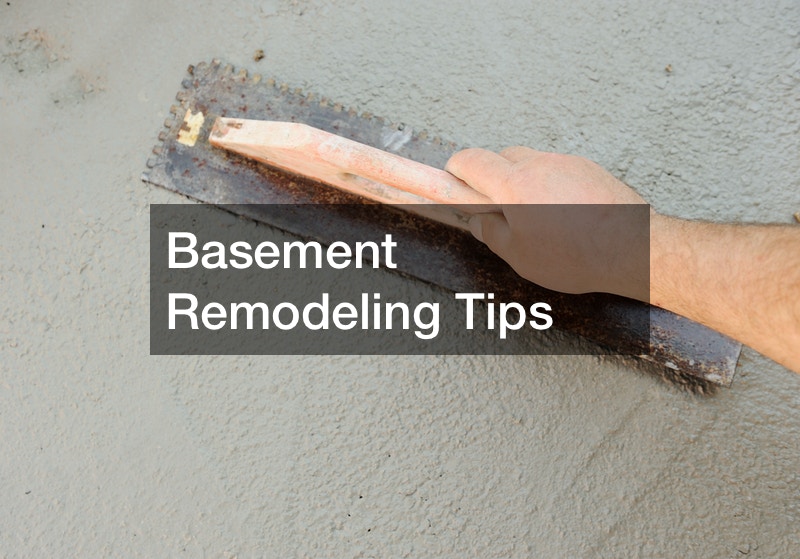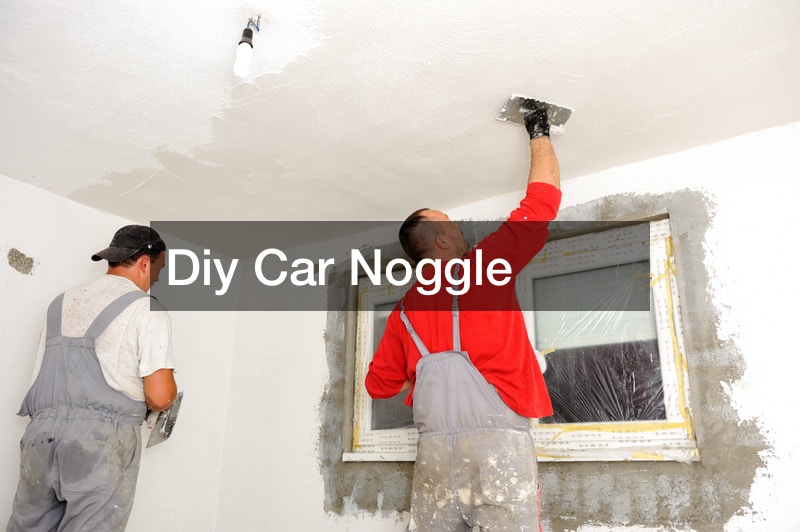
Finished basements are one of the top things that homeowners want, and they are one of the biggest renovation and remodeling projects that homeowners undertake. However, not all basements are created the same, and remodeling them isn’t something you should jump into.
If you are looking to remodel your basement, here are 10 basement remodeling tips that you need to keep in mind.

1. Solve Water Problems
In a finished basement, water issues can be terrible, and they can easily ruin all of your hard work. Even if you don’t think that your basement is very damp, you don’t want to add flooring until you know that any potential problems are fixed.
One of the first things you should do is have a home inspector who specializes in waterproofing, foundations, and basements come in and look over your basement. Because they are trained to look for even the smallest issues that can cause big damage, they’ll be able to tell you if your basement is ready for remodeling or if you have any water problems that will need to be fixed before you can get started.
Additionally, if you are planning on expanding your basement space by excavating further out from your home, you’ll want to have a plumber identify where all of the major water lines are so that you won’t be at risk of hitting them or messing up your plumbing. If you have a septic system, this can be especially important as you’ll need to know where the septic tank is, where it runs to, and where the drain field is located. Many commercial plumbing experts specialize in septic systems and they can easily tell where you should avoid expanding to.
2. Decide What Your Basement Will Be Used For
Once you are sure that you know water won’t be a problem, you can start brainstorming what the best use of your space will be. Many homeowners enjoy creating an isolated living space or theater area due to the lack of lighting and soundproofing that basements can provide. However, others may want to use the space to create a place for kids to play or teenagers to hang out where they can be loud without disturbing the rest of the house.
Some homeowners also use their basements to create additional bedrooms, bathrooms, and even office spaces, depending on what they need. However, when it comes to creating things like a bedroom, you will need to install a window in order for it to be officially recognized as a bedroom due to fire codes. This is especially important if you are ever planning on renting out the bedroom in the future for some additional income.
Regardless of what you decide to use your basement for, remodeling the space to make it livable can help you create the perfect custom home to suit your needs.
3. Consult a Design Expert
When you have decided what you want to use your basement for, you can consider consulting with a design expert to help you come up with the best layout possible to maximize your space. An architect or interior designer can help you create the best plan for your basement so that you end up with a final result that you love. Careful planning is key when remodeling your basement, and it isn’t something that you’ll want to jump into without a well-thought-out plan.
Additionally, a designer may come up with ideas that you would never have thought of, making their experience even more essential. For instance, you may not think you have space for an additional bathroom, but a designer could come up with a creative plan to give you one without it being intrusive or taking up too much space.

4. Consider Air Circulation
Air circulation can be crucial in basements and, unless your home was built with future basement finishing in mind, chances are you don’t have many — if any — ducts or vents downstairs. This will need to be carefully considered before almost anything else gets started, so that you can ensure that you have enough ventilation and clean air.
When installing vents and ductwork, you’ll also need to have a return air duct installed, and it’s important that this is located as far away from the furnace as possible. This is because it could draw in fumes that could then circulate throughout your home, creating a dangerous situation. An HVAC maintenance company will be able to tell you the best way to structure your new system so that it works as efficiently and as safely as possible.
That said, you should always install a carbon monoxide detector in your basement just so that you have a warning system in place if any venting problems do occur. Installing these throughout your home is always a good idea, with or without a finished basement.
5. Take Advantage of Natural Light When You Can
If possible, and if you’re not planning on creating a darkroom or theater space, you should always look for ways to bring in natural light. Window wells can be used for this, especially if you want to include a bedroom area. If part of your basement is above ground, you can even install windows at that level, or expand on ones that are already there. It is worth keeping in mind that window wells can increase the odds of water issues, as heavy rain can cause water to build up in them if drainage isn’t efficient. You may also use waterproof covers to help keep the water out.
Along with letting in natural light, basement windows are also important for creating escape routes in the event of a fire. However, some people worry that these windows could be targets for people looking to break in. One way to get the best of both worlds is by using glass bricks or tempered glass windows, which are harder to break. If you’re worried about creating an efficient escape route in case of a fire, lockable tempered glass is one of the best ways to go, and it can be easily opened from the inside when needed, but harder to break by would-be burglars.
6. Consider Artificial Light
If natural light isn’t an option, creatively using artificial light can be beneficial. Because basement ceilings are often lower than the ceilings in the rest of your home, they can often feel small and cave life. However, by using lights that illuminate larger portions of the ceiling, you can help create the illusion of space, making them seem higher than they are. Coupling this with recessed lighting, you can add variety and give yourself the ability to create many different lighting moods.
When using recessed lighting, you can also consider using LED smart lightbulbs which can be controlled directly from your phone. These lights can be dimmed and set to many different colors. Many also come with preset moods that you can choose from, such as reading, soft, night, and leisure. This gives you the ability to quickly change the lighting to fit any occasion instantly.
7. Consider Your Flooring
Because basements can be prone to dampness, your flooring contractor may recommend staying away from carpeted flooring if they feel like it may not benefit your home. While in some homes it may not be an issue, especially if you’ve taken steps to waterproof the space, if you live in an area prone to heavy rains and flooding, it is something to keep in mind.
Before getting started, you may want to head to a flooring store to learn more about the different types of flooring that are available so that you can get an idea of the type that you would want most. For instance, laminate wood flooring can give a sleek, polished look to your basement and it is easy to clean and maintain. You can also couple it with rugs if you want softer footing. Even concrete can be an option, and concrete sandblasters can give it a polished industrial modern finish that some homeowners may prefer.
You can also speak to your floor installers and ask about what they would recommend for your space based on what you plan to do with it. For instance, carpeting can increase soundproofing, but it can be harder to care for in the long term, especially if you have little kids who may spill things on it.

8. Insulation Is Key
When constructing your finished basement, you’ll also want to ensure that the walls are insulated. This will help keep your basement warmer and drier all year long. It can also help prevent condensation from accumulating when the warm air from your home interacts with the coldness of the uninsulated walls. This can cause moisture to build up, leading to mildew and mold, which can cause damage and even health issues.
Insulation prevents these issues and keeps your space more comfortable for you and your family.
9. Adding an Extra Bathroom
When remodeling a basement, it’s worth considering adding another bathroom if only to increase convenience. For example, if you’re using the space as a TV room, office, or bedroom, you’re not going to want to have to trek upstairs every time nature calls. This can get tiresome quickly, and by adding an extra bathroom you can avoid this.
Although some people opt to only install a half bath in the basements, you can really go as large as you like if you have the space and desire. For smaller basements, even something like a small standing shower can help give you the ability to create a fuller bathroom without taking up a lot of room.
Additionally, bathrooms are often easier to install in basements than anywhere else in the house, as they usually already have water lines within easy access.
10. Consider Your Furnishings
When it comes to furnishing your newly finished basement, practicality should be at the forefront of your decisions. For instance, because basements are often relatively small, it’s important that you are able to utilize the space effectively. This can mean using creative storage solutions or multipurpose furniture that allow you to maximize space and function. Modular couches, storage ottomans, and vertical storage containers can be key to allowing you to be able to use your space for numerous types of activities.
Additionally, if you are planning on creating a basement bedroom, rollaway beds or Murphy beds could be a great way to save on space, without sacrificing comfort. This could also be coupled with a built-in foldable desk so that the bedroom occupant also has a workspace that is non-intrusive.
An interior designer can also help give you ideas on creative ways to furnish your basement so that you can get the maximum amount of usage possible.

A Space You Will Love
When it comes to creating a finished basement in your home, there are a lot of things to consider. Remodeling your basement isn’t something that you should get started on without having a concrete plan in place that can act as a guideline for every improvement that you make.
Be sure to shore up any structural or water issues before getting started, and consider meeting with a designer to help you layout the framework that you will base your new basement on. Their insight can be invaluable for building the best basement living space possible. You should also consider the flooring materials beforehand, especially if you are concerned about water or messy kids.
By taking all of these steps before you get started, you can rest assured that once the remodeling is done, you will have a basement that you and your whole family can enjoy for many decades to come.



